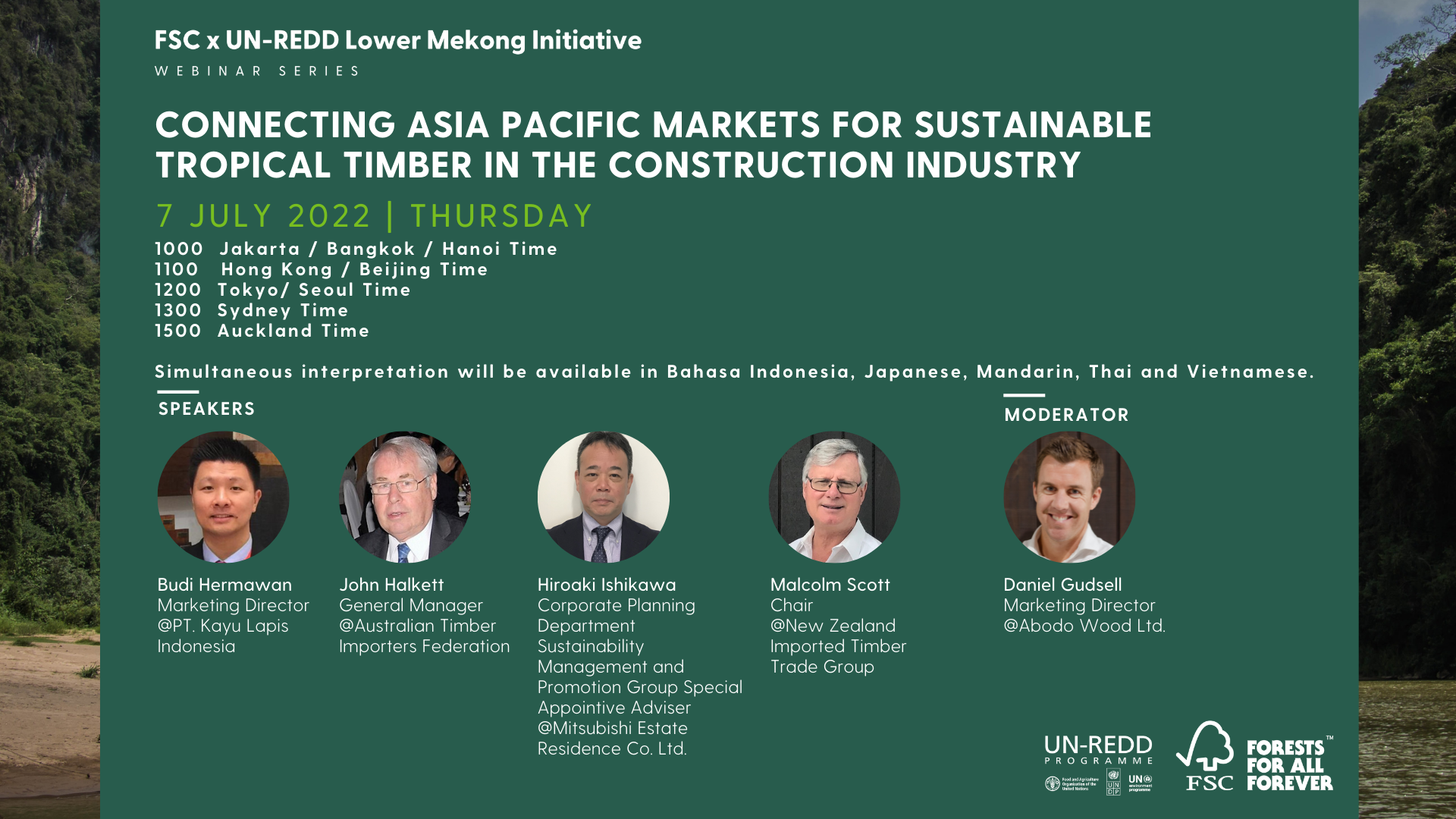Unsustainable tropical timber trade and investment practices have driven, and continue to drive, forest degradation and deforestation. FSC, a trusted global nature-based solution to these problems, is working to help brands and businesses address forestry-related issues by assisting them in mitigating their sourcing risks and achieving their sustainability commitments.
One way in which FSC does this in Asia Pacific is through the FSC x UN-REDD Lower Mekong Initiative – a project which aims to connect suppliers and buyers of sustainable tropical timber. On 7 July, the initiative held a webinar called “Connecting Asia Pacific Markets for Sustainable Tropical Timber with the Construction Industry”. The webinar moderated by Daniel Gudsell - Marketing Director of the Abodo Wood Ltd was full of dynamic discussions and active information sharing, brought together key stakeholders in the sector. Together, they illustrated how both demand and supply in the region have responded to calls to make the forest trade more sustainable. The key takeaways from the webinar are as follows:

Key Takeaways
John Halkett – General Manager of the Australian Timber Importers Federation:
- Forests in Southeast Asia are under significant pressure and the ability of countries in Southeast Asia to increase supply to Australia is in question.
- Papua New Guinea has the most potential, but there are serious problems with governance, sustainability and legality.
- The overarching issues in Australia are the size of the demand and the difficulty we have in sourcing timber wood. Traditionally-sourced supplies are limited and thus the Federation is looking for new suppliers.
Malcolm Scott – Chair of the New Zealand Imported Timber Trade Group (ITTG):
- New Zealand has a long history of importing timber, buying from many countries, including Papua New Guinea, various South American countries, the Solomon Islands, African countries, Fiji, and others. Wherever there are certified sustainable tropical hardwoods, you will find an NZ ITTG member buying timber.
- The NZ ITTG is very focused on sustainability. We are involved in an initiative to bring the market’s attention to the value of sustainability.
- We want homeowners and designers to not just focus on price and availability – we want sustainability to be part of their decision process.
- The ITTG wants to educate the market, with the help of merchants and importers, about the long-term importance of sustainable hard woods.
Budi Hermawan – Marketing Director at PT. Kayu Lapis Indonesia:
- Climate change and carbon emissions are constantly in the news. As a company, we want to combat climate change. One of our climate strategies is to promote wooden buildings.
- We also provide scholarship programmes to higher education institutes; fund teachers in forests, formal education in remote areas, and literacy programmes; and promote community involvement through sustainable production forests, the efficient use of raw materials, reduced impact logging, the sustainable management of natural forests, supply chain transparency and the responsible sourcing of raw wood.
- There are environmental and economic benefits to well-managed and sustainably-harvested forests.
- Environmental benefits – forests retain 90% of their carbon stores and biodiversity.
- Economic benefits – a steady supply of timber and jobs for the people who rely on forests,
- Sustainable forestry balances the needs of the environment, wildlife and communities. The benefits of FSC to the construction sector are many: zero deforestation, a positive climate impact, respect for Indigenous People’s rights, and fair wages and decent work environments for workers.
- Prefabricated construction is also sustainable as it uses less energy, produces little waste and can be constructed and installed quickly, since everything is done in the factory.
Hiroaki Ishikawa – Special Advisor to the Corporate Planning Department, Sustainability Management and Promotion Group at Mitsubishi Estate Residence:
- There are three reasons why tropical timber is used in construction:
- First, its strength. It can be used repeatedly and therefore is economically efficient.
- Second, the extent of its deformation is very small. Typically, when wood materials get wet, they tend to deform or stretch, but not tropical timber. This means that concrete surface finishes are highly accurate.
- Third is their ease of processing – this reduces workload and allows complicated shapes to be made.
- Tropical timber greatly contribute to reducing costs and energy usage on construction sites. I have recently heard about cases where construction workers say they prefer tropical timber over domestic plywood.
- Tropical timber plywood has become an essential part of apartment construction; but we cannot keep using it thoughtlessly as we must consider the forests.
- Our conclusion has been to support those who protect sustainably-managed forests. In order to do so, we need to know where the material comes from, and how particular forests are protected and managed. We also need to ensure that other timber is not mixed with sustainably-managed timber until the construction is complete.
- Mitsubishi Estate Group is committed to switching from all-concrete forming boards to certified materials by 2030. We believe that getting FSC-certified material will lead to strong support for timber producers.
- There is one challenge though: construction costs increase when using certified timber – an increase that comes from the price difference between general timber and certified timber, and from increased management costs to ensure traceability.
Any enquiries about the webinar, please contact asiapacific@fsc.org
More information:
FSC x UN-REDD Lower Mekong Initiative
